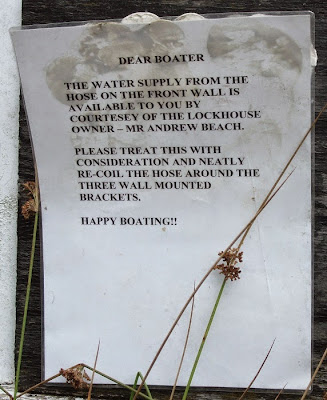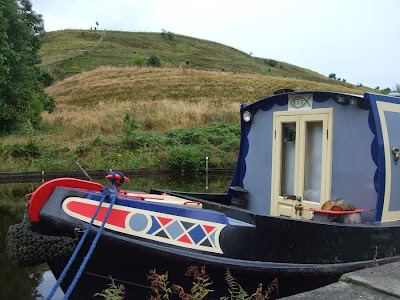By the time we'd come up Lock 63 the pound was only slightly down, so I nipped up on my bike to lower the top paddle and open the bottom gates. In nearly every lock I've had to open both bottom gates as few of them opened fully.
At several locks, a few feet behind the bottom gates there were the remains of what look like collar fixings for former gates.
I could see no other evidence of the locks having once been a different size. There was nothing in the masonry walls to show where heel posts might have been. So what are they?
At Lock 54, Slattocks Top Lock, we had a nice surprise. An A4 notice invited passing boaters to top up with water from the lock cottage owner's hose and outside tap. How convenient!
We just sat in the lock while filling up; I made coffee and Jan investigated a local shop. There was very little danger of holding anyone up - we knew there was no-one behind us, and no-one had come towards us. In fact, we saw no other moving boats at all today; the first narrowboat we saw was tied up where we moored after today's cruising in Littleborough.
Just after leaving Slattocks we caught sight of the Pennine hills in front.
I think I made more trips down the weed hatch today than the rest of the cruise so far, removing plastic, clothing and weed. Fortunately it has all come off the prop quite easily ... so far.
The worst stretch was through Rochdale, with rubbish swirling in the locks and lurking in the cut.
Above Lock 50, the closest one to Rochdale Station, was this pound where the navigable channel was obvious.
I must encourage Jan to take more pictures. She picked up my camera and snapped this one as she steered through Little Clegg Swing Bridge on the outskirts of Smithy Bridge. It's better than most of mine.
This is where we ended up this afternoon in Littleborough, within spitting distance of the summit. Well, what's 12 locks and two miles?
I see from Nicholson's that the summit level is not much more than half a mile long. Blink and you'll miss it. I think we'll have to tie up somewhere and explore by foot. The summit pound itself is probably not the best place to moor, as if anywhere is going to suffer a water shortage, that place is the Rochdale Summit.
Perhaps there'll be another deluge. We sheltered under a convenient road bridge during today's thunderstorm (thank you, Bridge 58). Again, we held no other boats up. After 20 minutes the rain had passed and we continued in sunshine. My coat dried quickly.
Tomorrow, then, we'll have been over the top and will have started our descent from Lancashire into Yorkshire. I expect there'll be a county boundary
We have had it easy on the Rochdale so far: nearly every lock has been in our favour. Today I had to turn just one, where obviously the bottom gates and paddles didn't leak enough. I wonder if going downhill we'll suddenly find the locks against us.
Oh - the title. Good value rubbish? Yes, you get a lot to the pound. (Groan!)




























2 comments:
The splayed white ironwork was for a frame to support iffy or weak tail gates when the lock was full. Beam across the lock width, beam from the centre of that to the mitre, and raking struts to hold it all together. Like a king-post roof truss but on its side. If it's still there you'll see a restored example at Brearley below Hebden Br. Look out for the curved "stubbin" posts too. When complete they allow the horse to get double purchase on starting and, if running blocks are used, the towrope falls off the post as the boat passes. The horse is then pulling normally. I say they were called "stubbin posts" because they were good for stubbin' your toes on. But perhaps they were invented at Stubbin Wharf above Hebden Br.
Thanks Bill. I like to know what things are/were for. I think I've seen the stubbin posts - about nine inches high, starting just off vertical and curving a few more degrees as it goes up. I think they are by the top gate.
Post a Comment